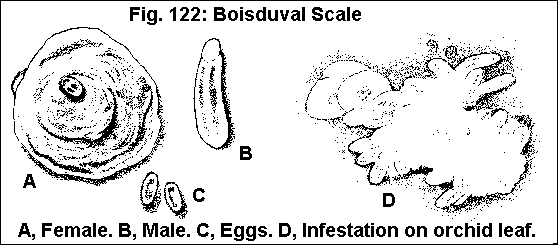
A, Female. B, Male. C, Eggs. D, Infestation on orchid leaf.
Return to: CFREC Home Page
Adult Female- Cover of the adult female boisduval scale is circular or oval, thin, flat, white to light yellow, semitransparent, and 1.2 to 2.25 mm in diameter. Exuviae central to subcentral in position.
Other Stages- The male cover is somewhat rectangular in shape, elongate, about 1 mm in length, and snow white with three ridges down the back.
Eggs- Boisduval scale eggs are oval and pale yellow to pale orange.
Nymphs- Newly settled nymphs are pale orange.

Distribution- Boisduval scale attacks orchids and palms in the warmer areas of California and Florida where these hosts are grown extensively. It can be found indoors in all parts of the world and is a common greenhouse pest.
Host Plants- Cattleya and Cymbidium orchids are the most common hosts, but this scale insect thrives on the leaves and bark of other orchids, palms, banana, and cacti.
Damage- New growth is frequently attacked prior to opening, and leaves may be killed if the infestation is dense. Lighter infestations produce irregular chlorotic spots that mark feeding sites and spoil the appearance of the leaves.
Life History- Under greenhouse conditions, boisduval scale can complete its life cycle in about 50 days. Females may produce up to 200 eggs in a lifetime. Eggs hatch in 5 to 7 days and most of the crawlers settle to feed within 24 hours after hatching. The first stage lasts about 10 days, the second about 8 to 10 days for females and 15 for males. After mating, females retain their eggs for a short period, then oviposit. Because females produce eggs over a long period, generations overlap, and usually all stages can be found at any one time. Crawlers can settle anywhere on the leaf, but seem to prefer the midrib and major veins.
Try to purchase plants from a supplier who does not have a scale infestation. When scales are encountered, horticultural oils give adequate control without excessive phytotoxicity. Two thorough treatments 2 weeks apart should give good control. Boisduval scale crawlers often establish themselves near the base of the plant and in leaf sheaths making control difficult. Also, both upper and lower leaf surfaces are attacked, so thorough coverage of any treatment is essential. For specific control recommendations, see the current Cooperative Extension publications on ornamental plant pest management or consult your county Extension agent.
University of Florida/IFAS Reference to Pest Control Guides